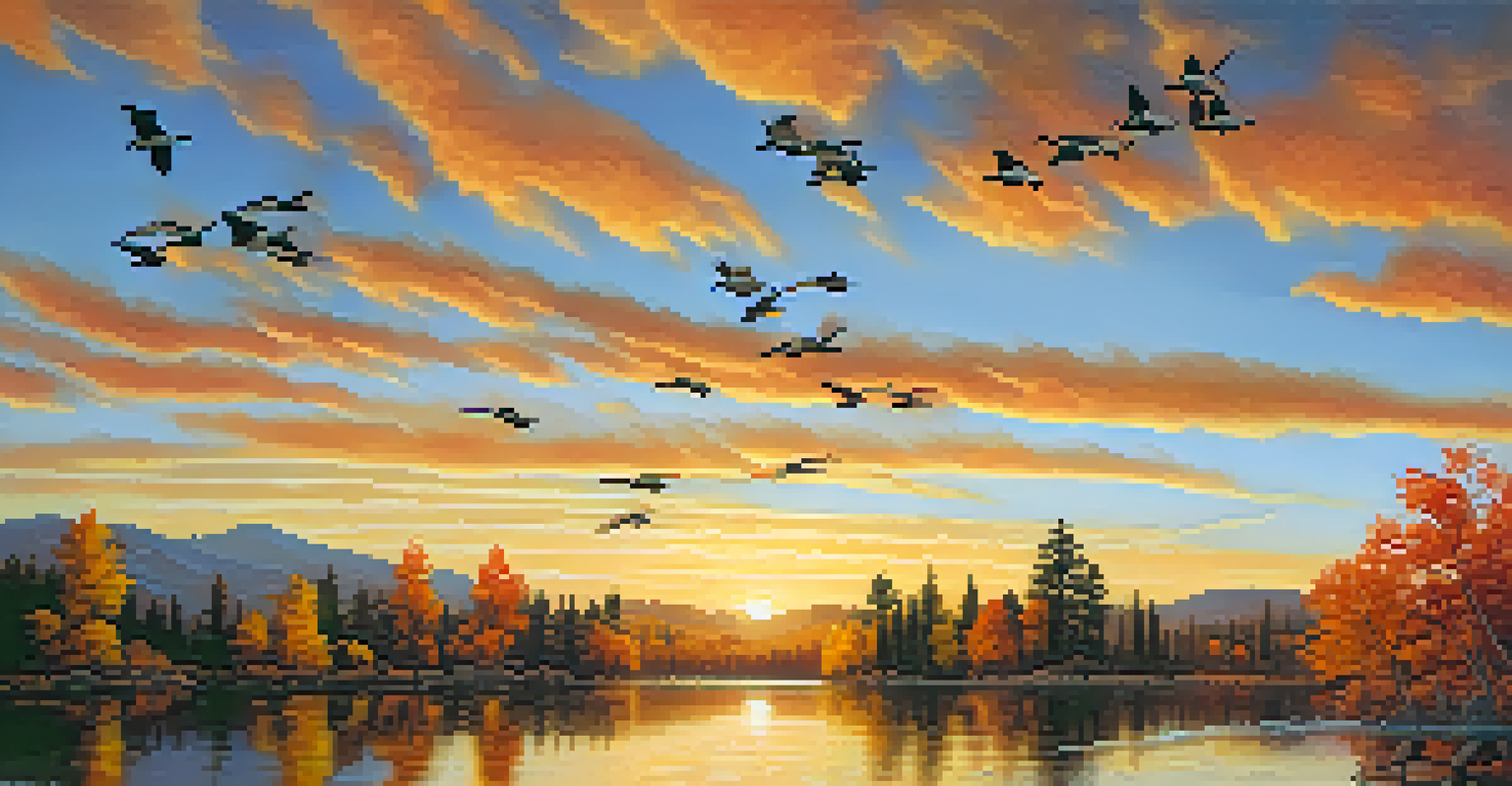Migratory Patterns of Birds in Big Bear Throughout the Seasons

Understanding Bird Migration: A Seasonal Journey
Bird migration is a remarkable phenomenon that showcases nature's incredible adaptability. Birds travel vast distances between their breeding and wintering grounds in search of food and favorable climates. In Big Bear, these patterns become particularly intriguing as various species arrive and depart throughout the year.
Birds are indicators of the environment. If they are in trouble, we know we’ll soon be in trouble.
The reasons behind migration can vary, but they often relate to seasonal changes in temperature and food availability. For instance, as winter sets in and food becomes scarce, many birds leave Big Bear for warmer regions. This seasonal journey is not just about survival; it’s also about carrying on the species' legacy.
Understanding these patterns helps us appreciate the delicate balance of ecosystems. By observing when and how birds migrate, we gain insights into climatic changes and their impact on wildlife. This knowledge enriches our connection to nature and highlights the importance of preserving habitats like Big Bear.
Spring: A Time of Return and Rejuvenation
As winter melts away, Big Bear transforms into a vibrant sanctuary for migratory birds. Each spring, various species return to the area to breed, filling the skies with their songs and colors. This annual return signifies not just the change in seasons but also the continuation of life and the intricate cycles of nature.

One of the most iconic birds to spot during this time is the western bluebird, known for its stunning blue plumage. They often arrive in March or April, seeking out nesting sites and forming pairs. Their arrival is a joyful reminder that life is bursting forth after the cold, quiet winter months.
Bird Migration: A Seasonal Cycle
Bird migration involves seasonal journeys as species travel to find food and suitable climates, showcasing nature's adaptability.
Additionally, spring is a prime time for birdwatchers, as many migratory species can be observed. This influx of birds creates a lively atmosphere in Big Bear, as they flit from tree to tree, showcasing their unique behaviors. It's a wonderful opportunity for locals and visitors alike to connect with nature and celebrate the beauty of migration.
Summer: Nesting and Raising Young
Summer in Big Bear is not only warm but also a bustling time for bird activity. Many species utilize this season to raise their young, making the area a nursery of sorts for fledgling birds. As parents tirelessly work to feed and protect their chicks, the air is filled with both excitement and the sounds of chirping.
The most effective way to do it, is to do it.
For example, American robins become particularly visible during summer, often seen hopping around gardens and parks. They take advantage of the abundance of insects and berries, which are crucial for feeding their young. This season illustrates the importance of habitat, as access to food sources is vital for the survival of these growing birds.
Summer also presents an opportunity for nature enthusiasts to witness the intricate behaviors of birds. From courtship displays to feeding routines, the summer months reveal the challenges and triumphs of avian life. It’s a reminder of how interconnected all living things are and the vital role each season plays in the cycle of life.
Fall: Preparing for Migration
As summer wanes, Big Bear's birdlife undergoes a transformation in preparation for migration. Many species begin to gather in flocks, signaling that it’s time to embark on their long journeys southward. This time of year is characterized by a flurry of activity as birds fatten up and strengthen their wings in anticipation of the trip ahead.
A notable example during this season is the Canada goose, which gathers in large groups. Their honking calls can be heard echoing across the lakes as they prepare for departure. This ritual emphasizes the urgency of migration, highlighting both instinct and necessity.
Impact of Climate Change
Climate change is altering migratory patterns, leading to mismatches in food availability and breeding times for various bird species.
Fall is also a great time for birdwatching, as the skies are often alive with the sight of birds in flight. Observers can witness the breathtaking formations of migrating flocks, a true testament to nature's beauty. It serves as a poignant reminder of the cycles of life and the importance of preparing for change.
Winter: A Quiet Time for Migratory Birds
During winter, Big Bear experiences a noticeable shift in its bird population. Many of the migratory birds have left, seeking warmer climates where food is more abundant. However, this season also brings a new set of visitors, such as certain waterfowl that thrive in colder conditions.
Birds like the common merganser can be seen diving in the icy waters, showcasing their adaptability. These winter residents demonstrate that not all birds migrate south; some are perfectly suited to endure harsh conditions. Their presence adds a different dynamic to the winter landscape, reminding us of nature's resilience.
Furthermore, winter presents a unique opportunity for birdwatchers to observe species that are less visible in warmer months. The stark beauty of snow-covered landscapes provides a stunning backdrop for spotting these hardy birds. This quiet time encourages reflection on the cycles of life and the importance of conserving habitats for all seasons.
Impact of Climate Change on Bird Migration
Climate change has increasingly influenced bird migration patterns, creating both challenges and adaptations for avian species. As temperatures rise and weather patterns shift, many birds are altering their migratory routes or changing the timing of their migrations. This can lead to mismatches between food availability and breeding times, which can threaten bird populations.
For instance, studies have shown that some species, like the black-throated blue warbler, are arriving at their breeding grounds earlier than in past decades. While this may seem beneficial, it can disrupt the delicate balance of ecosystems, as these birds rely on specific conditions that may no longer align with their migration schedules.
Conservation is Key
Conservation efforts are essential for protecting migratory birds and their habitats, ensuring the sustainability of biodiversity.
Understanding these impacts is crucial for conservation efforts. By monitoring changes and advocating for sustainable practices, we can help protect the habitats that are vital for migratory birds. Awareness and action can ensure that future generations continue to witness the awe-inspiring journeys of these remarkable creatures.
Conservation Efforts for Migratory Birds
The conservation of migratory birds is essential for maintaining biodiversity and healthy ecosystems. Various organizations and local groups in Big Bear are dedicated to protecting these species through habitat restoration and public education. Their efforts help to ensure that migratory routes remain safe and accessible for birds throughout their journeys.
One key initiative involves preserving wetlands and natural habitats, which serve as critical stopover points for migratory birds. These areas provide essential resources such as food and shelter during migration. By investing in the health of these ecosystems, we not only support bird populations but also enhance the overall environment.

Community involvement also plays a significant role in conservation. Local birdwatching groups often organize events and educational programs to raise awareness about the importance of protecting migratory birds. By engaging the public, we foster a collective responsibility towards preserving these beautiful creatures and their habitats.
Enjoying Birdwatching in Big Bear
Big Bear offers fantastic opportunities for birdwatching, making it accessible for both seasoned enthusiasts and curious newcomers. The diverse habitats in the area attract various bird species throughout the year, providing a rich tapestry of sights and sounds. Whether you're hiking in the woods or relaxing by the lake, there's always something to observe.
For those new to birdwatching, a pair of binoculars and a field guide can go a long way in enhancing the experience. Joining local birdwatching groups or participating in guided tours can also offer valuable insights into the migratory patterns and behaviors of birds. Plus, it’s a great way to meet fellow nature lovers!
Ultimately, birdwatching is about connecting with nature and appreciating the beauty of our feathered friends. Big Bear's stunning landscapes provide a perfect backdrop for this rewarding hobby. So grab your binoculars and head out—it’s time to discover the incredible world of birds!